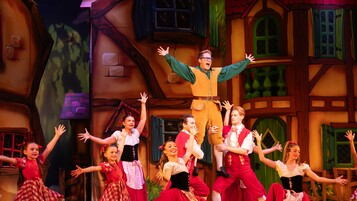News Story
Even the most passionate panto fans can’t claim to know everything about it. With a rich history and plenty of hidden depths, we’ve decided to pull together five things you may never have known about your favourite type of stage show.
Pantomime isn’t all that British
We consider pantomime a great British tradition and it’s something you’ll find at almost every local theatre and even large grand stage around the United Kingdom. However, the origins of the show are from British and date back all the way to ancient Roma.
The word pantomime comes from the Latin pantomimus which in turn is taken from Greek, with panto meaning “all” and “mimos” referring to a single actor or dancer who would carry out all the roles in a show. As the “mime” in the word also suggests, the original pantomimes were completely silent and almost the opposite of what we know and love today. The current iteration of panto in Britain comes more directly from 16th century Italy, and the commedia dell’arte tradition. Commedia dell’arte revolves around short sketches and dramas featuring recognisable masked characters. These small shows made their way over to England in the 17th century and became known as Harlequinades.
As the shows grew in popularity, they took over bigger and better stages in London and the British version of pantomime was born.
An all-male affair
While we’re used to seeing boys dressed as girls and girls dressed as boys in our pantomimes each winter, this wasn’t always the way. Men originally played all the roles in stage shows out of necessity and even the law of the land. Women were forbidden from taking to the stage for many years and it wasn’t until the 17th century that women were finally allowed on stage. Women were legally allowed to perform on stage from 1660 after King Charles II decided he was happy to watch women perform. You’ll still see men as women and women as men in pantomime and it’s a tradition that’s stuck and become integral to the classic panto experience.
Enjoy a long night
The average pantomime these days is around 2 hours, with an interval in the middle, but this wasn’t always the case. At the height of their popularity, the longer the show the better and there were many performances that tipped the 3-hour mark or even longer. The 1900 production of Sleeping Beauty and the Beast at The Drury Lane Theatre surpassed all expectations and went on for over five hours, and the audience stayed gripped and were thoroughly entertained.
Superstar casting
When your local panto details are released, we bet you look out for the big-name stars arriving for the season. Whether it’s a big reality TV star, a soap princess or a legendary pantomime dame, it’s the norm to look out for the stars of the show before booking in. Many legendary and world-famous acting talents have taken to the boards and are veritable pantomime veterans from Pamela Anderson as the Genie in Aladdin to Sir Ian McKellen’s Mother Goose. The chance to perform in panto is on many actor’s bucket lists and while some only give it a go once or twice, others (we’re thinking Chris Biggins here) are in show year after year.
Panto success overseas
Pantomime can be confusing for people viewing it for the first time, and American audiences in particular are famous for not quite getting the humour. This is not the case in all regions, however, and in some countries, they have their own unique variations of what we consider a classic British show.
A lot of the countries that enjoy a panto have a history that links them to the British Empire, including Australia and Canada, so maybe this has influenced their interest in this classic form of theatre. Some other nations have combined pantomime with their own traditional storytelling methods. In Jamaica, you’ll find amazing pantomimes which intermingle with the local Anansi folklore of their heritage. Despite the general confusion America has with pantomimes, plenty of their big-name stars are more than happy to star in the shows, including David Hasselhoff.
Whether you’re a huge fan of panto or simply enjoy the occasional show we hope you’ve learned something new here and picked up one or two lesser-known panto facts to share.
If this has whetted your appetite for seeing a pantomime this year, why not book your ticketsto watch Snow White & the Seven Dwarfs at Bournemouth Pavilion from 3 - 31 December 2023. Click here to book your tickets now!



